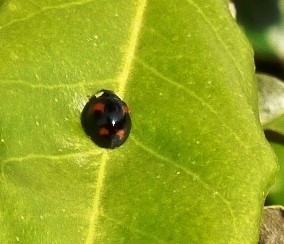
The total monthly rainfall in October was 30.5 mm with a maximum daily rainfall of 6 mm on the 20th.. The hottest day of the month (16th) reached 21°C whilst the coldest days(30th and 31st) fell to 13°C. October was a rather windy, cloudy month with 18 days having 100% cloud cover for at least part of each day, and a further 6 days having at least 75% cover. It was generally mild with overnight frosts on the mornings of the 28th and 30th.
-
 Pine ladybird
Pine ladybird
Pine ladybird
Pine ladybird
-
 Poplar in mid-autumn
Poplar in mid-autumn
Poplar in mid-autumn
Poplar in mid-autumn
-
 Oak in mid-autumn
Oak in mid-autumn
Oak in mid-autumn
Oak in mid-autumn
-
 Southern hawker in hedgerow
Southern hawker in hedgerow
Southern hawker in hedgerow
Southern hawker in hedgerow
https://www.kentfieldclub.org.uk/news/little-barton-farm-wildlife-notes/october-2017#sigProId526387fac2
As usual during October there were few first-sightings to be seen. We recorded the crane fly Tipula paledosa on the 14th, having failed to see it with the more plentiful Tipula maxima during spring. Similarly, we noticed a pine ladybird (also called the 4-spotted) on the 15th (see photo) having failed to see it in spring, when the more plentiful 7-spotted ladybird was first active. Our final first-sighting was a grey moth of the Epirrita sp. on the 25th, three of which we disturbed in the wood and were almost certainly November moths.
Wildflowers have died back progressively throughout the month until there are now only a few species left in bloom, We lost bird’s foot trefoil on the 6th, watermint on the 9th, and fleabane on the 11th. Later in the month we saw our last red clover on the 28th, plus yarrow and white deadnettle on the 29th. We have also continued removing creeping thistle flower seed-heads throughout the month, and seem to have now completed this task for the year. We believe we have 9 flowering species left on site.
Butterflies are very dependent on the presence of sunshine and wildflowers, and have thus declined accordingly. Our last small white was on October 5th, followed by green-veined white and common blue on the 14th. Next day (15th) came our last small tortoiseshell and peacock, speckled wood on the 17th , and large white on the 19th. We have not seen the comma since the 25th or small copper since the 27th, but the red admiral has been prominent throughout the month, especially around an apple tree in our garden where drops are still plentiful.
Dragonflies too have only appeared in small numbers during the month, and we have had to be very diligent in hunting them down. Cloudy skies mean only fleeting glimpses of sunshine, so they are in hiding for much of the day. Our last ruddy darter was on the 19th, and southern hawker on the 20th (see photo). This leaves us with small numbers of common darters and migrant hawkers going into November.
This has been a stuttering month regarding autumn colours on our trees and shrubs. As early as the 1st there was considerable leaf-fall due to strong winds The effect of this was to remove the autumn-tinted leaves from the trees and deposit them on the ground. Thus, the trees which started their autumn colours early soon become bare, while those which coloured later continued to look green instead of a combination of green, yellow, orange and brown. Our photographs of the poplar and the oak, taken on October 16th (mid-autumn) dramatically show the result of this process.
On 11th October the first ash trees were showing full autumn colouring, with some of the hornbeam following on the 16th. Horse chestnut leaves turned their familiar full brown by the 25th, and wild cherry leaves were red by the 31st. First trees to lose all their leaves were the poplar and ash on the 16th. This coincided with the deposition of sand from the Sahara and pollution from the forest fires in Spain and Portugal during the remnants of Hurricane Ophelia, which turned our sun dull red. Some elder were also bare by the 28th.
The unidentified wave moth referred tin the September report was later identified as a willow beauty.
